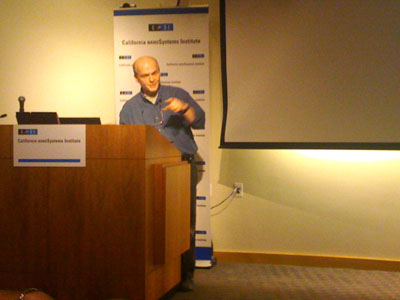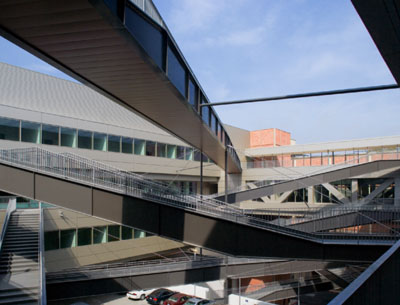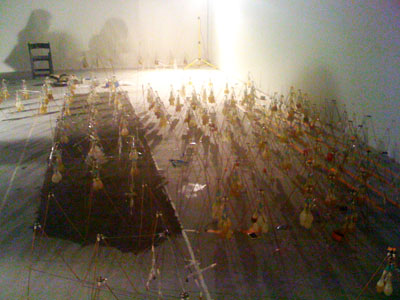 Philip Beesley
Philip Beesley
In another lesson in how great it can be to be part of a major research university, I attended a talk last Friday given by University of Waterloo architect and designer
Philip Beesley, at the
California Nanosystems Institute on campus that was part of the
Body Art Disease symposium last weekend. Beesley has completed many pretty typical building projects, but seems to focus a lot of his energy on experimental installation projects. A major defining interest appears to be in what he calls “mechanical empathy”, or a mechanical construct's ability to respond to human interaction. He spent a significant amount of time showing slides of renaissance paintings of bible scenes, and focused specifically on how textiles are represented in the works. This was apparently to highlight how something inert like textiles can respond to or resonate with emotional context, or how the material world echoes human conditions. Beesley apparently considers his installations as something like the fabric in the paintings of Jesus: responding to the human conditions they cover; this link to his own work was not made forcefully enough for me for the amount of time he spent on the paintings though.
 Beesley's fabric obsession - I considered snapping a picture when he was gesturing at a hugely enlarged jesus crotch swaddled in cheesecloth, but I ended up being too modest
Beesley's fabric obsession - I considered snapping a picture when he was gesturing at a hugely enlarged jesus crotch swaddled in cheesecloth, but I ended up being too modest
He also showed slides of two other dominate themes in his installations: linking systems (he showed railways built to connect the coasts of Canada and a very early Buckminster Fuller sketch presupposing the global networks of today), and prosthetics (slides of geotextiles supporting turf growth on hillsides and stem cell impregnated biodegradable gauze growing new skin for burn victims). Despite spending a fraction of the time on these other themes as was spent on the renaissance paintings, the connection to his work seemed much more natural and easy to make.
Beesley's work is very interesting stuff; from
structural matrices made of twigs blanketing a forest floor, it evolved to laser cut plastic structures creating membranes that
passively draw in material from the surrounding environment, to similar structures that were actively powered with muscle wire to
actively respond to environmental factors like the human touch. This all led up to his installation upstairs from the lecture in the Nanosystems building called
Endothelium. As a side note, the
Nanosystems building, which is by Rafael Viñoly, is pretty boring on the outside (I'm not a huge Viñoly fan) but it has a very interesting courtyard - angled stairways shoot across a huge void going several stories below the pedestrian plaza entrance level, and one whole side of the building is totally unsupported for like 300 feet - cantilevered over a parking structure and the huge HVAC plant required for all the labs - all giving it a feel that I overheard other students describe as Blade Runner-esque and like a set for Gattaca (which was actually shot in a Frank Lloyd Wright building in my hometown).

 CNSI building photo and drawings from the Viñoly press release pdf
CNSI building photo and drawings from the Viñoly press release pdf
Anyway, back to Beesley - the installation was not completed on the day of the lecture, and volunteers were actually still working while the lecture was being given. Despite it's incompleteness (and I believe they did eventually get it done last weekend), it was still captivating and very atmospheric, despite being at a smaller scale than his most recent work. It sounded like it was meant to be another geotextile of sorts, like his first twig installations, though it was installed indoors here. In the lecture, he described it as a shift from the most recent work - away from heavy computing and electrical use towards more delicate semi-independent cells that are powered by "natural batteries" (latex balloons full of chemicals that generate electricity). The batteries power cell phone vibrator units attached to some of the tripods, which have barbs as feet. The vibration is meant to drive the barbs into soil, giving them more solid purchase. When it rains, clips holding sheets of cellulose paper dissolve and send strips of paper shooting out onto the ground. Maybe the raining thing is why it wasn't installed outside here in its LA incarnation - we already had our one rainy day of the year a few weeks ago, ha ha.

 Incomplete but still evocative
Incomplete but still evocative
I'm not sure what the purpose of the installation would be if it were to be actually installed in a natural environment. Maybe the cellulose supports plant growth? I suppose a lot of the point with these new media type installations is to test the technologies and techniques, which I'm not totally opposed to. I don't expect every installation piece to have some "higher function", but I do wish Beesley had talked a bit more about what at least his intentions were with each piece, even if they don't actually DO anything but look impressive. Especially in light of his comments closing out the talk - that he is "interested in making a contribution". The bulk of his installation work (from after the twig pieces up until the piece before the UCLA installation) features similar "traps" - porous membranes with cups and even syringes that supposedly draw material in. I had to ask in the q & a portion what he imagined that "material" to be - he said it was human material: heat plumes or dead skin, hair, and such. I think he might have mentioned something like "human energy" too, which resonates with my first reaction to one of his piece's titles: Orgone Reef, which sounds like Wilhelm Reich's concept of "Orgone Energy" - a kind of pervasive sexual energy (which was the subject of a hugely captivating movie by one of my favorite directors -
WR: Mysteries of the Organism by Dusan Makavejev). So maybe Beesley is just afraid of being ostracized as a crackpot (as Wilhelm Reich was) if he discussed his true intentions for what the pieces actually "do", but I think it would be an interesting discussion.
At the conclusion of the discussion, we were invited to a reception at the Biosciences Library. The prospect of free food and wine is always difficult for me to turn down, but a bunch of us architecture kids went up to check out the installation first and missed the main group going over to the library. The few of us who decided to find the reception (well outside our normal sphere of influence, which is centered in the arts area in the northern corner of campus) set out on what turned into an epic trek of something like 40 minutes. Despite members of our party giving up and peeling off we finally found the right building, but were confronted with seemingly endless halls out of The Shining, or maybe Being John Malkovich, but full of weird science dioramas and eyewash stations in the hallway. After asking for directions like 5 times we finally found the library and were at last directed to the correct floor. When the last hardy members of our little band found the plush reception (weirdly in the middle of the bioscience library stacks) we were like pilgrims reaching the new world. I think the art and science people eyed us a little oddly as we gobbled up the astonishing bounty (they had calamari rings, baked brie wheels, baguettes and unlimited pour-yourself wine!!) but we didn't care. Shortly after we got there, a talk started in the rare books room, which was actually really interesting. The woman who apparently curates the rare books section for the library gave a talk called "Renderings of the Body Through Time and Text" about the "depiction of the human body in states of health and disease" by showing "first editions of seminal texts of medical illustration" from the collection, which also includes a good number of artist books with bio-sciences themes. Unfortunately my phone ran out of batteries or I would have taken pictures, but we were shown an incredible range of books, from a Persian book on optics from the 1100s to incredible hand-painted medieval dissection books. I'm not normally one of those who has an obsession with old technical illustration, but these examples were just so gorgeous that I couldn't help but be captivated. If you're in the LA area and ARE one of those with unhealthy obsessions for technical drawings, the entire special collection in the rare book room is open to the public - I'd strongly recommend a visit. Check it out
here.
After the rare books talk, I went back to Perloff to find the AUD's bimonthly happy hour still in full swing, and was happy to take a crack at the keg. Fortunately, my basins group members were similarly inebriated and were busy riding their classmates' fixie bikes around the courtyard, so I didn't have to do any work that night. Not that I'd have been able to, between wine at the biomed library and the full keg at Perloff. What a nice Friday. Great times apparently can be had on campus, contrary to my previous belief!






3 Comments
(With regard to the Beesley presentation) As much i was annoyed with the ecumenical overtones of some of his slides, I respected his passion and insight into more ephemeral realms than just the mechanical. With regards to designing for other ( or higher) fields of energy, I personally am fine with designing orgone collection devices if one is so inclined, and would have handled such conversations within an academic setting equally as prudent as he did. I mean you get similar convictions in discussions about Feng Shui.
I did leave feeling somewhat bewildered and confused, but realized later that it was genius, and that I respected him designing for correspondence of energy fields that are not as of yet recognized officially by the Church , er I mean the University. Architectural discourse rarely broaches such ontological and spiritual situations....and this was all done happenstance ( or not ) in an arena for studying nanotechnology. Go figure.
Mark, I totally agree with you. I'm just about the most atheist person person I know (with a low tolerance bordering on INtolerance even for feng shui or astrology), but I think Beesley could have talked about orgone energy or whatever in that setting and it would have only added to understanding of his intentions. Unless that's just a convenient naming device and he actually isn't interested in some alternative concept of human energy. In which case we're still left with the question: what are all these resources and energy (electrical, human-caloric, AND orgone!) being spent on these installations for?
Oh, also what was that movie you told me to see? I remember only that it sounded interesting. Even if I hadn't been buzzed at the happy hour I wouldn't have remembered, ha ha.
"All plasmatic matter perceives, with or without sensory nerves. The amoeba has no sensory or motor nerves, and still it perceives. Each organ has its own mode of expression, its own specific language, so to speak. Each organ answers to irritation in its own specific way: the heart with change in heart beat, the glad with secretion, the eye with visual impressions and the ear with sound impressions. The specific expressive language of an organ belongs to the organ and is not a function of any ‘center in the nervous system’...milliards of organisms functioned for countless thousands of years before there was a brain. The terror of the total convulsion, of involuntary movement and spontaneous excitation is joined to the splitting up of organs and organ sensations. This terror is the real stumbling block..."
Wilhelm Reich, ‘Orgonomic Functionalism’,
in Selected Writings: An
Introduction to Orgonomy, 1960
(Farrar, Straus and Giraux, 1961)
Block this user
Are you sure you want to block this user and hide all related comments throughout the site?
Archinect
This is your first comment on Archinect. Your comment will be visible once approved.